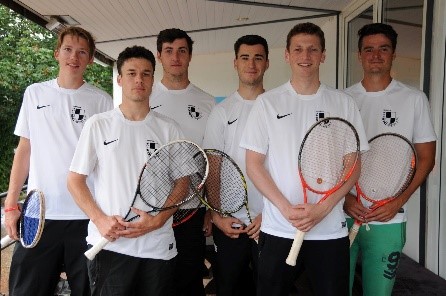OVERCOMING OBSTACLES WITH SPORT
For many, finding the right sport can be difficult when living with hemophilia. I chatted to my good friend and fellow editor, Tobias, about his personal experience of becoming a keen tennis player whilst living with hemophilia.
I know that you love to play tennis, but when did you start? Did you find it difficult to get involved in sports as a child?
I started playing tennis when I was around 6 or 7 years old. My dad enjoyed playing tennis and encouraged me to play with him. Hemophilia did play a role in which sports I could do – for example, all my friends played soccer and I desperately wanted to as I really wanted the matching club jersey that they all had! However, soccer was too high impact for me at the time, so I joined the same club but just played tennis instead.
I know what you mean. It’s so important to take hemophilia into consideration with training and sport, even if it is tough when you’re a teenager and want to fit in! Do you do anything else to adapt your activities to your medical needs?
When I was younger, you could hardly tell the difference between me and my peers, so I fitted in well. I played tennis once a week and just took my medicine on the day that I wanted to play. In my late teens, I started playing a lot more frequently and I also started coaching. To make sure my treatment matched my increased activity, I stayed in close contact with my treatment center, where I was monitored very closely and my treatment was personalized to suit the level of activity I wanted to do.
What is the one thing that you wish people with hemophilia knew more about when it comes to sport?
You can do a lot more than you think you can! Therapies and treatments can be closely personalized to suit the level of activity that you want to do, so your hemophilia doesn’t need to limit your activity. In fact, activity guidelines for people with hemophilia (PWH) highlight the many benefits of playing sport, including improvements in physical fitness and the development of increased flexibility and muscular strength, which may actually reduce the risk of injury. Several studies also report that physical activity can improve the effectiveness of treatments and decrease the likelihood of bleeding episodes in PWH.
In contrast to those studies, there are a lot of resources that advise people with hemophilia to stick to ‘low impact’ sports. Do you think perceptions of hemophilia and sport have evolved over time?
I think there’s been a big shift in thinking around sports and hemophilia. It used to be unthinkable for a person with hemophilia to play soccer, but it’s been made possible with the right therapy and treatment. There’s also more talk now about the need for people with hemophilia to stay active, especially in Germany. I do think it’s important to note, however, that we need to listen to our bodies and not push our limits too far. Treatment is expensive and not everyone has access to therapy, so these people do need to be a lot more careful when playing higher impact sport.
What advice would you give to someone with hemophilia who wants to stay active and get involved with different sports?
Go for it! Always speak to your doctor about therapy first, but don’t let hemophilia stop you from achieving your goals.
You should consult your physician or other healthcare professional before starting any new physical activity









